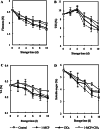Analysis of flavor and taste attributes differences treated by chemical preservatives: a case study in strawberry fruits treated by 1-methylcyclopropene and chlorine dioxide
- PMID: 33087951
- PMCID: PMC7550547
- DOI: 10.1007/s13197-020-04474-7
Analysis of flavor and taste attributes differences treated by chemical preservatives: a case study in strawberry fruits treated by 1-methylcyclopropene and chlorine dioxide
Abstract
Flavor and taste attributes of fruits varied by different preservatives treatments. Changes in sugars, organic acids, amino acids as well as volatiles of strawberries treated with 1-methylcyclopropene (1-MCP) and/or chlorine dioxide (ClO2) were evaluated during storage period in this study. Our results revealed that the decreases of tartaric acid, malic acid, citric acid, titratable acidity (TA), sucrose and soluble sugar contents were significantly inhibited by 1-MCP + ClO2. The fructose and glucose contents of all groups remained stable and slightly increased at the last period of 10 days. However, different treatments had no influence on content of succinic acid. Moreover, the highest sweet taste (77.37 mg 100 g-1 fresh weight) and lowest bitter taste (3.44 mg 100 g-1 fresh weight) free amino acids (FAA) were observed in the strawberries treated by 1-MCP combined with ClO2 treatment as compared to other treatments and control. (E)-2-hexenal was the most abundant volatile and showed a significant increase trend during strawberry storage. More interestingly, ethyl butyrate, fruit-like aroma, could be recovered in content by 1-MCP, ClO2 alone and their combination treatment. Compared with other treatments, the significant different flavor in ClO2 treatment was identified by principle component analysis. In addition, methyl hexanoate and 4-methoxy-2,5-dimethylfuran-3(2H)-one (DMMF) were the major factors that affected the volatile organic compounds (VOCs) of strawberries through the whole storage. Taken together, 1-MCP coupled with ClO2 could be a complex preservative to maintain strawberries quality by regulating the flavor and taste attributes.
Keywords: 1-MCP; ClO2; Flavor; Strawberry; Vocs.
© Association of Food Scientists & Technologists (India) 2020.
Conflict of interest statement
Conflict of interestThe authors declare no competing financial interest.
Figures



Similar articles
-
Chlorine dioxide fumigation generated by a solid releasing agent enhanced the efficiency of 1-MCP treatment on the storage quality of strawberry.J Food Sci Technol. 2018 Jun;55(6):2003-2010. doi: 10.1007/s13197-018-3114-1. Epub 2018 Mar 14. J Food Sci Technol. 2018. PMID: 29892100 Free PMC article.
-
Effect of One-methylcyclopropene (1-MCP) and chlorine dioxide (ClO2) on preservation of green walnut fruit and kernel traits.J Food Sci Technol. 2015 Jan;52(1):267-75. doi: 10.1007/s13197-013-0996-9. Epub 2013 May 8. J Food Sci Technol. 2015. PMID: 25593369 Free PMC article.
-
1-methylcyclopropene effects on temporal changes of aroma volatiles and phytochemicals of fresh-cut cantaloupe.J Sci Food Agric. 2013 Mar 15;93(4):828-37. doi: 10.1002/jsfa.5804. Epub 2012 Jul 20. J Sci Food Agric. 2013. PMID: 22821412
-
The aroma volatile repertoire in strawberry fruit: a review.J Sci Food Agric. 2018 Sep;98(12):4395-4402. doi: 10.1002/jsfa.9039. Epub 2018 May 20. J Sci Food Agric. 2018. PMID: 29603275 Review.
-
The flavor of pomegranate fruit: a review.J Sci Food Agric. 2014 Jan 15;94(1):21-7. doi: 10.1002/jsfa.6311. Epub 2013 Aug 19. J Sci Food Agric. 2014. PMID: 23881410 Review.
Cited by
-
The Effect of Imidacloprid on the Volatile Organic Compound Profile of Strawberries: New Insights from Flavoromics.Foods. 2023 Jul 31;12(15):2914. doi: 10.3390/foods12152914. Foods. 2023. PMID: 37569183 Free PMC article.
-
Role of Microbial Volatile Organic Compounds in Promoting Plant Growth and Disease Resistance in Horticultural Production.Plant Signal Behav. 2023 Dec 31;18(1):2227440. doi: 10.1080/15592324.2023.2227440. Epub 2023 Jun 27. Plant Signal Behav. 2023. PMID: 37366146 Free PMC article. Review.
-
Synergistic effects of 1-MCP and H₂S co-treatment on sugar and energy metabolisms in postharvest strawberry fruit.Front Nutr. 2025 Jun 2;12:1615783. doi: 10.3389/fnut.2025.1615783. eCollection 2025. Front Nutr. 2025. PMID: 40525134 Free PMC article.
-
Genome assembly of wild loquat (Eriobotrya japonica) and resequencing provide new insights into the genomic evolution and fruit domestication in loquat.Hortic Res. 2022 Dec 2;10(2):uhac265. doi: 10.1093/hr/uhac265. eCollection 2023 Feb. Hortic Res. 2022. PMID: 36778182 Free PMC article.
-
Classification of Strawberry Maturity Stages and Varieties Using Neural Networks Based on Volatile Organic Compounds.Foods. 2025 Jan 8;14(2):169. doi: 10.3390/foods14020169. Foods. 2025. PMID: 39856837 Free PMC article.
References
-
- Abonyi BI, Feng H, Tang J, Edwards CG, Chew BP, Mattinson DS, Fellman JK. Quality retention in strawberry and carrot purees dried with Refractance WindowTM System. J Food Sci. 2002 doi: 10.1111/j.1365-2621.2002.tb09452.x. - DOI
-
- Caleb OJ, Wegner G, Rolleczek C, Herppich WB, Geyer M, Mahajan PV. Hot water dipping: impact on postharvest quality, individual sugars, and bioactive compounds during storage of “Sonata” strawberry. Sci Hortic. 2016 doi: 10.1016/j.scienta.2016.07.021. - DOI
-
- Chen Z, Zhu C. Combined effects of aqueous chlorine dioxide and ultrasonic treatments on postharvest storage quality of plum fruit (Prunus salicina L.) Postharvest Biol Technol. 2011 doi: 10.1016/j.postharvbio.2011.03.006. - DOI
LinkOut - more resources
Full Text Sources
Miscellaneous
